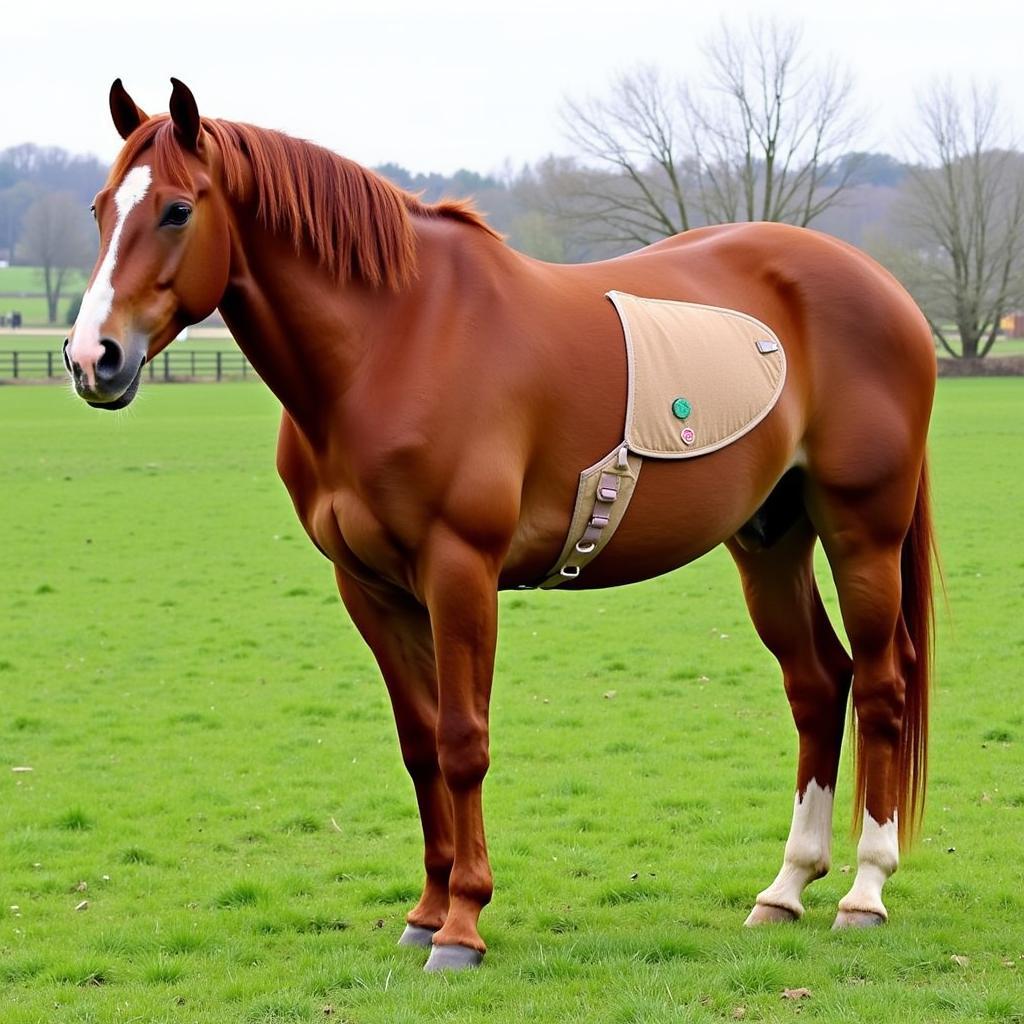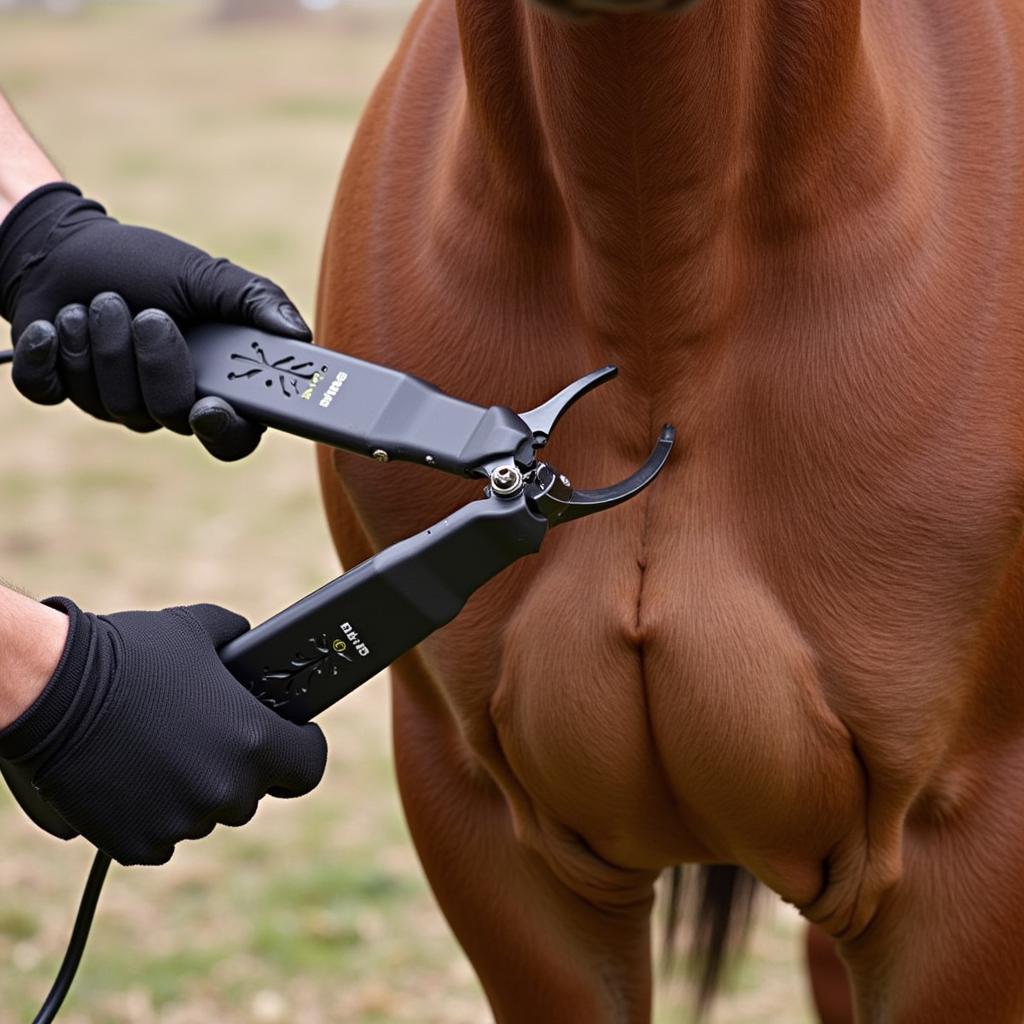Bib clipping your horse is a common practice during the colder months, offering a balance between warmth and comfort while managing sweat and moisture. This guide delves into the intricacies of bib clipping, providing you with the knowledge and expertise to make the best decisions for your equine companion.
Understanding the Bib Clip for Horses
A bib clip removes hair from the horse’s chest and underside of the neck, resembling a bib or apron. This strategic clipping helps regulate body temperature, preventing overheating during exercise while still providing protection from the elements. It’s a popular choice for horses in light to moderate work during winter, especially those prone to sweating.
Why Choose a Bib Clip?
The bib clip offers a range of benefits for horses in varying climates and workloads. It’s a versatile clip that caters to horses needing some protection from the cold while mitigating the risks associated with excessive sweating. Horses who are clipped fully often require extra rugs and blankets, which can become cumbersome and restrict movement. A bib clip allows for more freedom and natural thermoregulation.
Advantages of Bib Clipping
- Temperature Regulation: Prevents overheating during exercise.
- Reduced Drying Time: Less hair means faster drying after workouts.
- Simplified Grooming: Easier to clean and manage the clipped area.
- Comfort: Prevents chills from trapped sweat.
 Horse with a Bib Clip Standing in a Paddock
Horse with a Bib Clip Standing in a Paddock
When is a Bib Clip Appropriate?
- Light to Moderate Work: Ideal for horses exercised regularly but not intensely.
- Climates with Fluctuating Temperatures: Offers flexibility in changing weather conditions.
- Horses Prone to Sweating: Helps manage moisture and prevent chills.
How to Perform a Bib Clip
Bib clipping is relatively straightforward, but careful preparation and technique are crucial.
Essential Equipment:
- Clippers: Sharp, well-maintained clippers designed for horses.
- Clipper Blades: Choose the appropriate blade length for your horse’s coat and desired finish.
- Clipper Oil: Keeps the blades lubricated and prevents overheating.
- Chalk or Marker: To outline the clipping area.
- Extension Cord: Ensure you have sufficient reach.
Step-by-Step Guide to Bib Clipping:
- Prepare Your Horse: Ensure your horse is clean, dry, and comfortable. A twitch may be necessary for nervous horses.
- Mark the Clipping Area: Use chalk or a marker to outline the bib shape on your horse’s chest and neck.
- Start Clipping: Begin at the lower chest and work upwards, following the marked lines. Use smooth, even strokes.
- Overlap Strokes: Slightly overlap each stroke to avoid leaving lines.
- Check Blade Temperature: Regularly check the clipper blades for heat and lubricate with clipper oil.
- Blend the Edges: Use thinning shears or a lower blade setting to blend the clipped area with the unclipped coat for a natural look.
 Clipping a Horse's Chest
Clipping a Horse's Chest
Caring for a Bib Clipped Horse
Proper care is essential to maintain a bib clipped horse’s comfort and health.
- Blanketing: A lightweight rug or blanket may be necessary in colder temperatures.
- Monitoring for Chills: Pay close attention to your horse for any signs of being cold.
- Regular Grooming: Keep the clipped area clean and free of dirt and debris.
Common Bib Clipping Mistakes to Avoid
- Clipping too high: Extending the clip too far up the neck can leave the horse vulnerable to cold.
- Uneven lines: Take your time and use clear markings to ensure a neat and symmetrical clip.
- Using dull blades: Dull blades can pull the hair and cause discomfort.
“A well-executed bib clip can greatly improve a horse’s comfort and performance during the winter months,” says renowned equine veterinarian Dr. Emily Carter. “It’s a valuable tool for managing thermoregulation and preventing chills.”
Conclusion
Bib clipping provides an effective solution for managing your horse’s coat during the colder months, promoting comfort and preventing overheating. By understanding the benefits, techniques, and aftercare associated with bib clipping, you can ensure your horse stays healthy and happy throughout the winter season. Remember, a bib clip can significantly improve your horse’s wellbeing.
FAQ
- How often should I oil my clipper blades?
- Can I bib clip my horse myself?
- What type of blanket should I use on a bib clipped horse?
- How long does a bib clip last?
- What are the alternatives to a bib clip?
- Is a bib clip suitable for all horses?
- Can a bib clip be used in conjunction with other clips?
For further information, explore our articles on full body clipping and trace clipping.
Need help? Contact us! Phone: 0772127271, Email: [email protected] Or visit us: QGM2+WX2, Vị Trung, Vị Thuỷ, Hậu Giang, Việt Nam. We have a 24/7 customer support team.